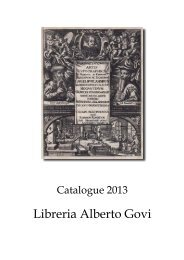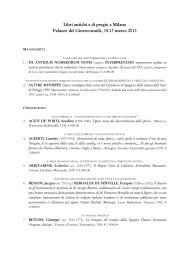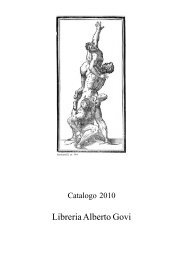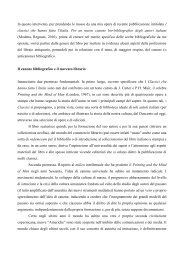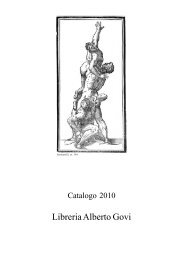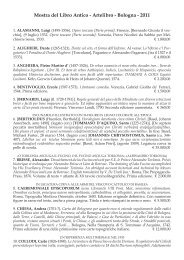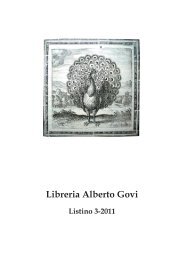List 4-2013 - Libreria Antiquaria Alberto Govi
List 4-2013 - Libreria Antiquaria Alberto Govi
List 4-2013 - Libreria Antiquaria Alberto Govi
Create successful ePaper yourself
Turn your PDF publications into a flip-book with our unique Google optimized e-Paper software.
inserito nuovi episodi e ne ha spostati o eliminati altri” (I. Rocchi, Lo stile del “Fido Amante”, in: “Cavalieri ed eroi…”, op. cit., pp. 153-154).<br />
Curzio Gonzaga belonged to a minor branch of the Gonzaga family, that of the marquises of Palazzolo. In 1549 he undertook a military<br />
career. In 1556 he was imprisoned for one year for having insulted a certain Raffaele Ghivizzano during a dinner at the table of the duke of<br />
Mantua. A protégé of cardinal Ercole Gonzaga, from 1557 on, he was charged with many diplomatic missions. He was sent to the Farnese court<br />
during the war between the Spanish and the French army. In April 1559 he represented the duchy of Mantua at Cateau-Cambrésis and soon<br />
after he met emperor Charles V. In September of the same year, he followed cardinal Ercole Gonzaga to Rome to attend the conclave after the<br />
death of pope Paul IV.<br />
He then decided to settle in Rome, where he had made the acquaintance of many litterati and where he had been admitted to the Accademia<br />
delle Notte Vaticane, which asembled in cardinal Carlo Borromeo’s palace. He was obliged to return to Mantua at the end of 1575. From<br />
then on he lived mainly between Mantua and Borgoforte, where he had a villa full of statues and paintings, devoting himself to the writing of<br />
his long poem Il Fidamante. In those years he hosted a literary circle in his villa and remained in epistolary exchange with his friends in Rome<br />
and elsewhere. In 1585 he published a collection of Rime.<br />
He spent the years 1591 and 1592 in Venice. In 1595, duke Vincenzo I granted him the castle of Palazzolo in Monferrato and the title<br />
of marquis. Gonzaga, who suffered of gout, continued however to reside in Borgoforte, devoting himself to the study of theology. He died<br />
in Borgoforte in 1599 (cf. O. Grandi, Di Curzio Gonzaga e delle sue opere, in: “Per Cesare Bozzetti. Studi di letteratura e filologia italiana”, S.<br />
Albonico et al., eds., Milano 1996, pp. 535-546; and P. Peretti, Curzio Gonzaga Marchese di Palazzolo, in: “Curzio Gonzaga fedele d’amore,<br />
letterato e politico”, Atti del Convegno di Studi, Torino, 1999, A. Villata, ed., Rome, 2000, pp. 147-148).<br />
Maddalena Campiglia, born into a wealthy family of Vicenza, studied literature and music in her youth. In 1576 she married Dionisio<br />
Colzé, from whom he separated in 1583. She then joined the Third Order of St. Dominic. Her religious feelings are expressed in her first larger<br />
work, the Discorso intorno all’Annunciatione della Vergine (1585). Becoming known as a writer, she made the acquaintance of Torquato<br />
Tasso, who expressed himself positively on her pastoral play Flori (1588), which, like the eclogue Calisa (1589), is dedicated to Curzio Gonzaga<br />
(cf. G. De Marco, Maddalena Campiglia. La figura e l’opera, Vicenza, 1988, passim).<br />
Edit 16, CNCE 21439; A. Erdmann, My gracious silence, Luzern, 1999, p. 210. € 2.200,00<br />
- 24 -



